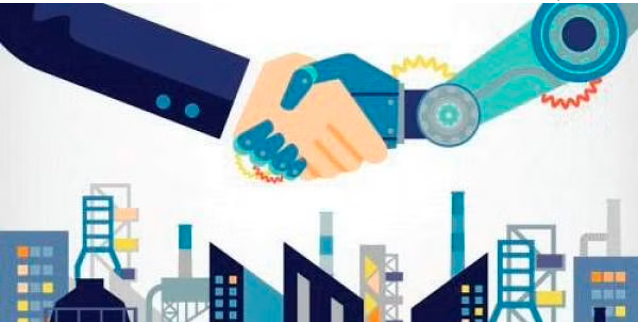
By Surjith Karthikeyan
The Fourth Industrial Revolution (4IR) or Globalisation 4.0/Industry 4.0 is formed by technologies such as artificial intelligence, machine learning and the internet of things (World Economic Forum). It has multidimensional aspects such as social, economic, political and cultural upheavals and may unfold over the course of modern times. This is indeed a continuation of widespread digital technologies available as a result of the third industrial revolution. This was preceded by the second one, the use of electric power for mass production, which lasted till 1920, and the first industrial revolution, wherein water and steam were a source of power. Globally, though the quality of life and global income levels have improved along with a reduction in cost of essential services and increase in overall productivity and efficiency, inequality with low-skill, low-pay and high-skill, high-pay segments prevailed leading to social tensions. The 4IR may further fuel supply-side miracles as above, paving the way for new avenues in economic growth, supported by the internet of things as a whole new experience of interconnectedness. As these revolutions have their own potential opportunities and challenges, it may be interesting to explore how governments the world over are exploring the 4IR.
Japan has initiated the concept of “Society 5.0” or a super-smart society wherein one can resolve various social challenges by incorporating the innovations of the 4IR. The emphasis is on “sustainable and inclusive socio-economic systems” to be realised by digitalisation. The internet of things, robots, artificial intelligence, big data, etc., will solve problems of ageing society, depopulation in regions, income inequality and so on, and people can focus more on creative work with full use of the five senses, collaboration and knowledge sharing. Germany, an European example where at present more than 15 million of the country’s population depends on the manufacturing sector, had planned to build on its international competitiveness to explore the enormous potential of 4IR to become the leading factory-equipment supplier. ‘Platform Industrie 4.0’ was constituted in this regard with the involvement of 300 stakeholders from 159 organisations. Estonia, the most advanced digital society in the world, on the other hand, focuses on Industry 4.0 solutions development, specialising in helping electronics manufacturers and adopting a real-time factory approach.
ADVERTISEMENT
Japan has formulated an act on special measures for productivity improvement wherein regulatory sandbox, promotion of industrial data utilisation, etc., are covered. Tax reduction on capital investment by Small and Medium Enterprises (SMEs) and companies actively investing in equipment and IT is another broad measure. This is coupled with subsidies for manufacturing and service of SMEs and promotion of regulatory reforms such as the “system improvements of self-driving cars”. Regulatory reforms for digital platform businesses, promoting investment in infrastructure systems and technology, and partnership with private sector and academics for creating innovation are the key issues being addressed in this context. The challenges listed by Japan in this regard include concerns of “digital autocracy”, influence and innovative power of social media, cybersecurity, and analysis and strategy for future unemployment figures, estimated to be around 2.4 million.
How is India placed? What are the opportunities and threats? Studies conducted by the World Bank, Oxford University, etc. on the relative global positioning of our country in the 4IR reveal that India is lagging in technology integration and adequate capital investment needed. In spite of low automation and a young workforce, absolute job losses will be the second highest in the world due to 4IR. Thus, without technology integration, India may lag in productivity as is expected to be achieved through 4IR. India may be adding 138 million new workers in its workforce in due course, which is likely the highest in the world, and it may be a challenge to step up its growth rate to compensate for both high job loss and high incremental workforce. If the country has to grow, it may have to invest heavily in adoption of new technology and reskilling/redeployment of a large share of its current workforce. The threats for India in the Fourth Industrial Revolution may be that the shift of manufacturing towards consumption centres may shrink the net exports, resulting in huge job losses in the manufacturing sector. Machine learning and AI may wipe out most of human analytics and programming-based high-end outsourcing jobs in India known as Knowledge Process Outsourcing.
However, the opportunities for India in the 4IR is that the huge middle class and working class may be sustaining consumption-based growth for many decades. Lower taxation rates in India due to a low-dependency economy may be making it an attractive choice for foreign investment. The government has already started the “Make in India” project, which may modernise the design and fabrication process in our manufacturing industry, keeping the requirements of 4IR. The government’s Smart Cities project, when revolutionised with the internet of things, can enable all appliances to be connected through a network, and services will be delivered through automation. The cities that are selected strategically for this project may allow equitable distribution across the country.
Way forward: The broad challenges of 4IR globally include loss of jobs due to advanced technology, loss of privacy, digital environment footprint, inequality due to haphazard economic development, fast spread of fake news and related issues. So it is imperative for jurisdictions to continuously adapt to a new, fast-changing environment to understand what they are regulating and to be more transparent in public engagement and policymaking. The countries also need commitment to upskill the labour force in digital technology and to look at the changing threats to national and international security.
